From Sebastiaan about one of his favorite countries: Ukraine! A complete Ukraine travel guide, including tips and tricks on travel in Ukraine. This guide to travel in Ukraine was compiled after six months of traveling and living in Ukraine divided over three visits in 2018, 2019, and 2020.
As of 24/02/2022 Russia has invaded Ukraine. Ukraine’s airspace is closed and there is open armed conflict. We don’t recommend anyone to visit right now.
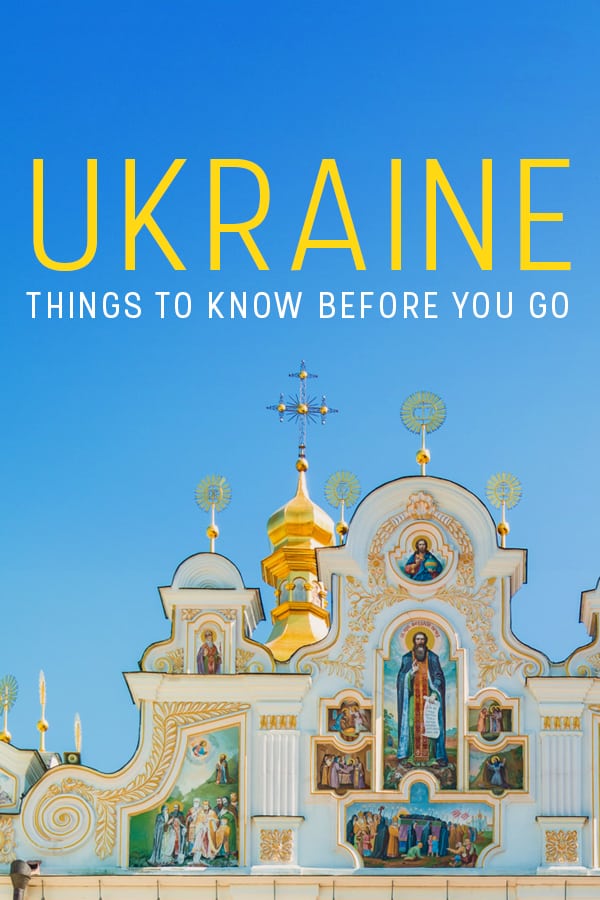
Pin it!
Ukraine is a large country wedged between the European Union and Russia. Despite being considered dangerous by many due to the war in the east, Ukraine is actually an incredible—and safe—country to travel!
With ever more affordable flights to Ukraine available daily, plus bus and train services from within the EU now connecting to major cities like Lviv and Kyiv, tourism is sure to pick up in the coming years.
I compiled this list of things to know about Ukraine after six months of traveling and living in the country. It’s almost guaranteed to answer everything you need to know about traveling in Ukraine. If not, you can always ask for more!
Ukraine Travel Guide Index
- Background
- Ukraine, a name
- Best time to visit
- Language
- Culture
- Religion
- Food
- Money
- Visas
- Entering and exiting
- Transport
- Safety
- Connectivity
- Places to visit in Ukraine
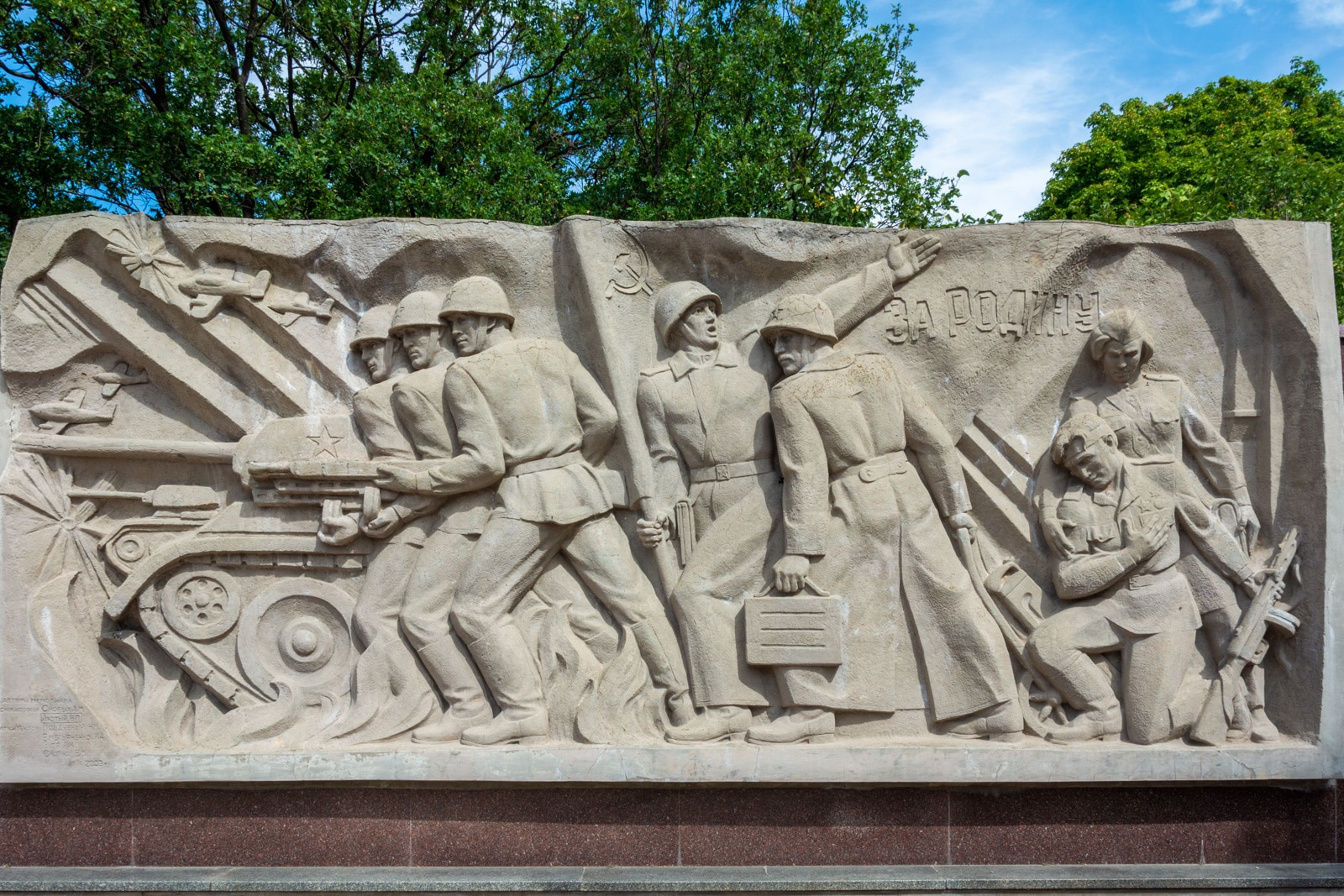
Soviet remnants in Ukraine
Some background about Ukraine
Ukraine’s history is long, tragic, and often violent.
Modern-day Ukraine has been independent since 1991, but it traces its roots back to the Kyivan Rus’ Federation. Both Russia and Belarus derive their name from Kyivan Rus’, and Kyiv was the capital of the Federation. The Federation lasted from the 9th till the 13th century, when Mongol hordes invaded and leveled Kyiv.
From this point on, Ukraine has been in a geographical flux, with many parts of the country contested for. Lithuanians, Poles, Cossacks, Tartars, Russians, Germans, and others all had a shot at ruling parts of Ukraine throughout history.
In more recent history, Ukraine was part of the Soviet Union, although the Galician part of Ukraine (Western Ukraine around Lviv) didn’t become part of the Soviet Union until after World War 2. Ukraine became independent in 1991 after the Soviet Union collapsed.
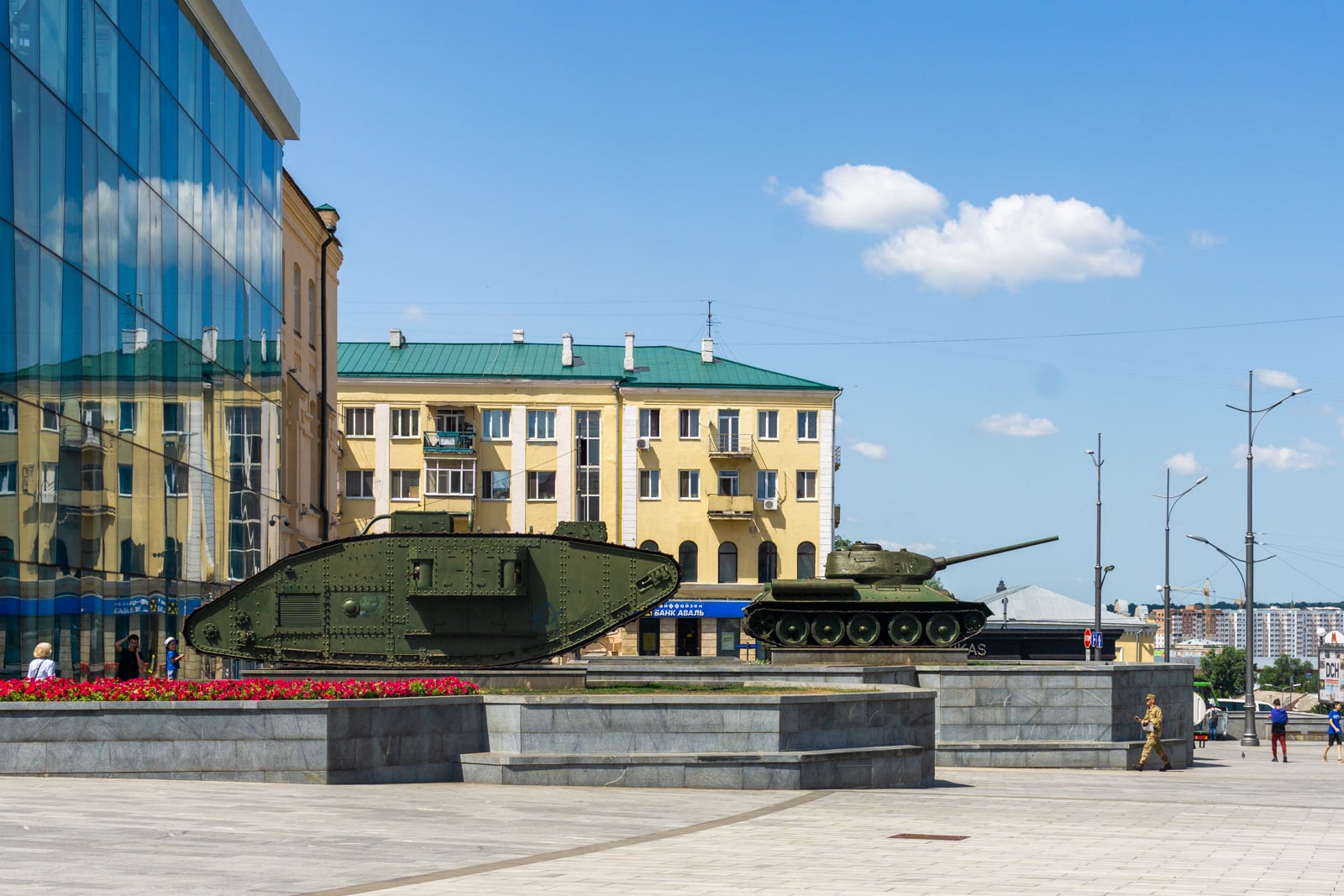
War relics in Kharkiv
Revolutions in Ukraine
Since its independence, Ukraine has seen two revolutions:
In 2004, the so-called Orange Revolution took place after then Prime Minister Yanukovich was declared the winner of rigged elections. The Orange Revolution was largely peaceful and resulted in Yanukovich being ousted in favor of Viktor Yushchenko and Yulia Tymoshenko.
In 2014, the Euromaidan Revolution happened. Yanukovich came back to power by promising closer integration with Europe and the European Union, but instead moved to sign a treaty with Russia. This led to peaceful protests on Independence Square in Kyiv (Maidan), which turned violent when riot police showed up and assaulted the peaceful protesters. This led to more peaceful protests until Anti-Protest Laws were passed, specifically aimed at muting the Euromaidan protests.
After this, protests turned more violent. Riot police fired active bullets at protesters, and protesters in turn used military and guerilla tactics to thwart the riot police. After escalations resulting in more than 100 people’s deaths, Yanukovich signed the agreement on the settlement of the political crisis in Ukraine. He fled the country soon after, and was granted political asylum in Russia.
Euromaidan indirectly led to the Russian annexation of Crimea, and the War for Independence in the East. For those who want to know more, I highly suggest the documentary ‘Winter on Fire’ on Netflix.

The national flag
A bit about names
The name of the country is Ukraine.
This might seem obvious, but many people still refer to Ukraine as “The Ukraine” (looking at you, North Americans). However, “The Ukraine” has negative connotations: it’s associated with the idea the country is just a region of a greater (Russian) empire. Again, it’s Ukraine, not The Ukraine.
In the same vein, the official name of Ukraine’s capital city is Kyiv, not Kiev. This is another source of contention in Ukraine. However, most western media and people still refer to the capital as Kiev. This Ukraine travel guide will use the official spelling. Ukraine’s government has repeatedly asked big media outlets (not including this blog) to start using the official spelling.
For many Ukrainians, the name “Kiev” refers to how the city was named under Russian rule, using the Russian way of spelling. Visitors to Ukraine are often confused by this, as they assume Kiev is harmless Anglicization of the name. Many Ukrainians feel differently.
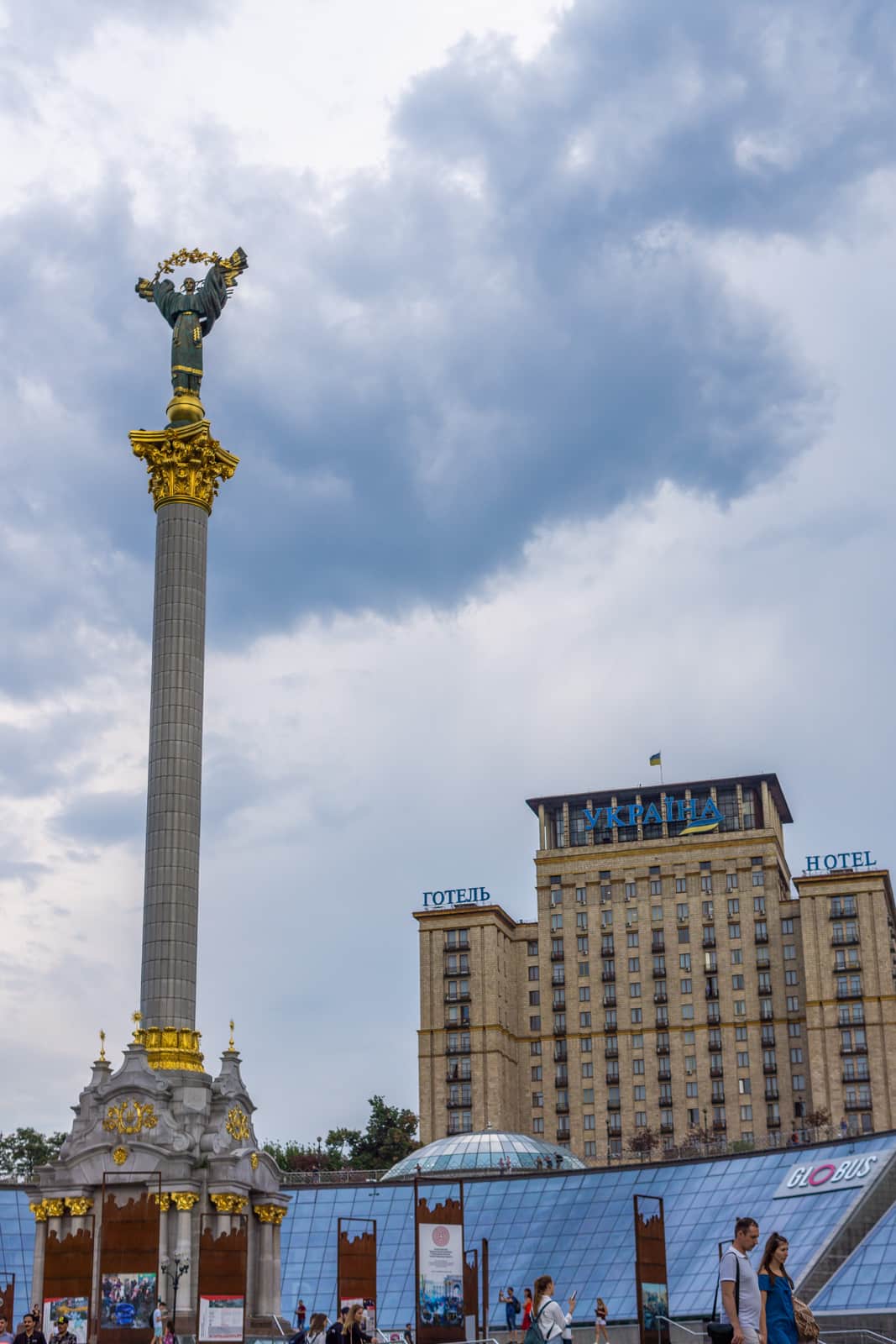
Maidan in Kyiv
Best time to visit Ukraine
The best time to travel to Ukraine is in spring or fall. The weather is pleasant, terraces are set up outside, and there a several pop-up bars that come to life around this time. Fall colors are also really pretty
If you want to visit the Carphantians, summer is the best time to travel to Ukraine. Although it might rain at times, in general, you’ll have perfect hiking weather. Many people also go to Odesa during summer, although I would personally try to come before the summer rush. Odesa gets packed during summer.
Traveling around during summer can also be a literal pain, and most buses and marshrutka don’t open their windows, even when it’s bloody hot outside (a leftover Soviet believe that draft winds make you sick is to blame for this).
Winters are generally cold and wet, and often snowy. If you want to go skiing in the Carpathians, this is the time. It’s still possible to go, as long as you pack warm clothes, but it’s not the best time of year to visit Ukraine.
Language in Ukraine
The official language of Ukraine is Ukrainian. However, a sizable part of the population speaks Russian, especially in the east and south of the country. Ukrainian is more dominant in Western Ukraine.
Ukrainian or Russian?
Many people think Ukrainian and Russian are basically the same languages with minor differences. To the untrained ear, it might sound so, but in reality, they’re remarkably different. Most Ukrainian speakers will be offended if you assume they’re similar.
As for traveling in Ukraine, it’s useful to pick up some Russian and Ukrainian. Russian is a useful language all across Eastern Europe and Central Asia. If you want to travel comfortably in western Ukraine, it helps to know Ukrainian.
Although the majority of Ukrainians speak both languages to an extent, people in the west are not fond of Russia and Russian. Knowing a few words of Ukrainian will make basic interactions much smoother. Having said that, if you only speak Russian, you won’t have trouble traveling in Ukraine.
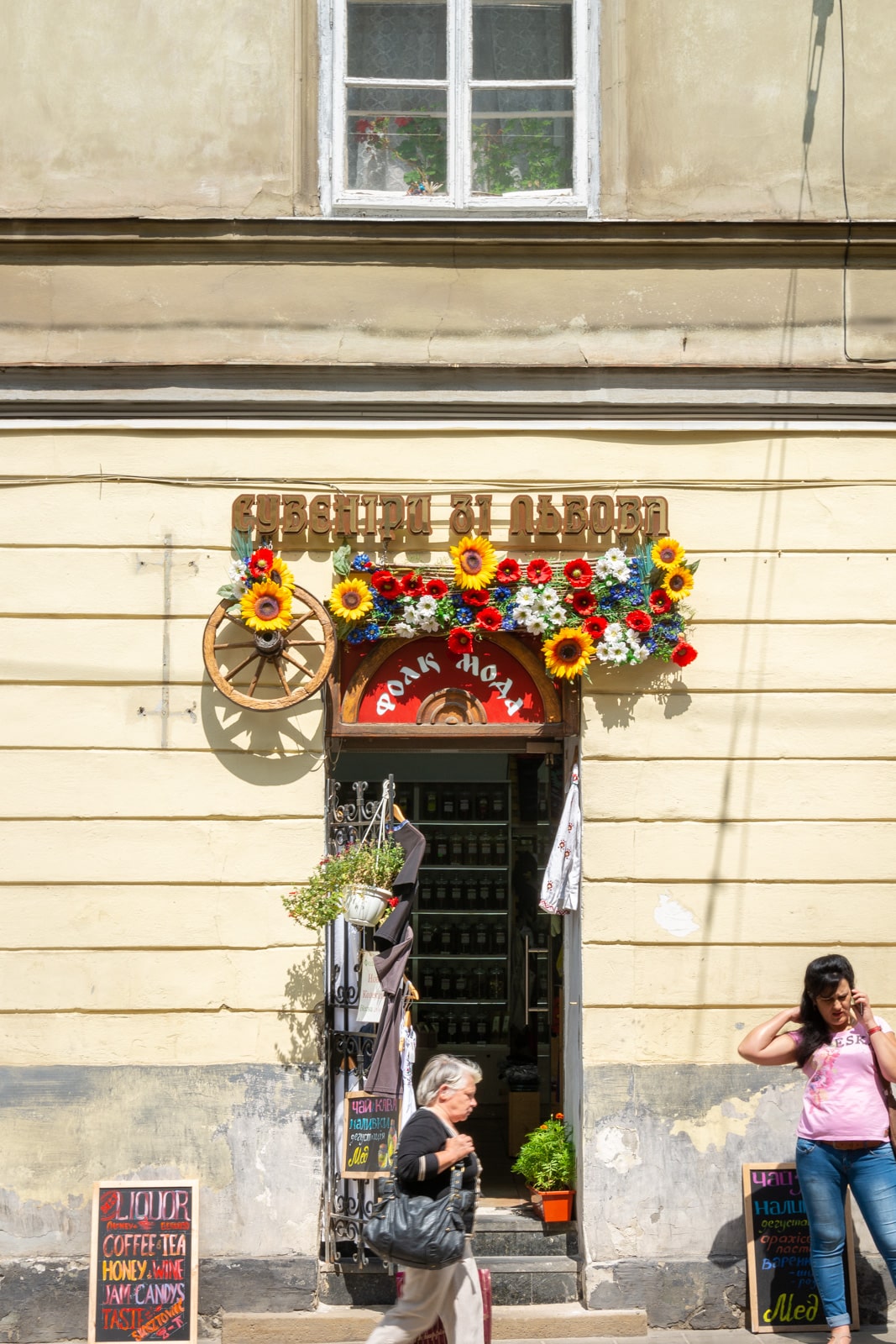
A store in Lviv
Alphabet
Ukraine uses the Cyrillic alphabet. If planning to visit Ukraine for more than a week or two, I highly recommend you learn it. It took me about a day and a half to learn the alphabet, and I’m incredibly happy I did so. Duolingo is a good resource for this.
Do people speak English in Ukraine?
In cities, many young people speak English, although they might claim they don’t out of shyness. In towns and villages, it’s more difficult to find English speakers. Be prepared to flex your Ukrainian and Russian… or traveler sign language. Google Translate also works reasonably well for Russian.
Most restaurants in cities like Lviv and Kyiv will have English menus.
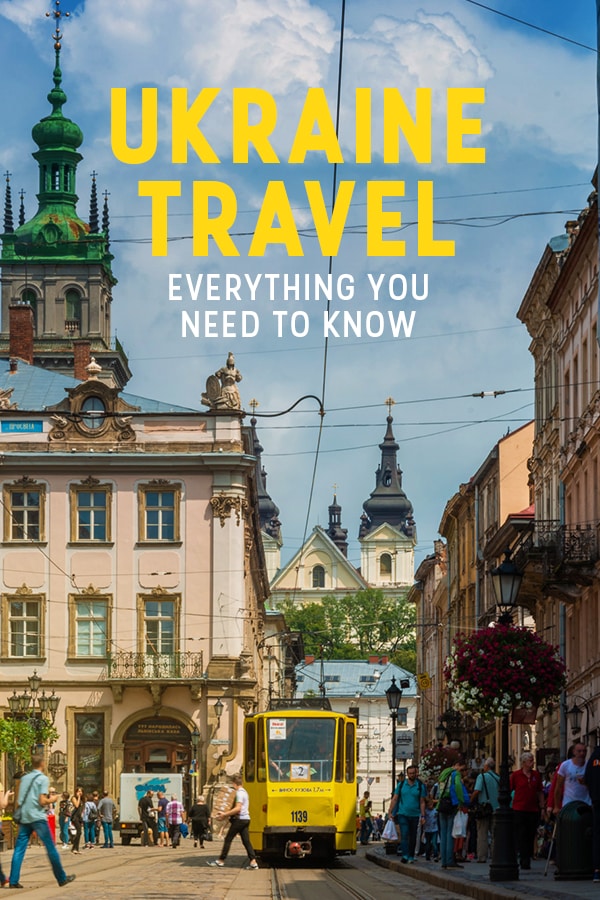
Helpful? Pin it!
Culture in Ukraine
Despite active oppression through the ages, Ukraine has a proud and lively culture. Embroidered clothes, musical instruments, folk art, and literary achievements are all part of Ukraine’s rich cultural heritage.
It’s not uncommon to see young people wearing traditional embroidered clothes, especially on public holidays. These outfits are a feast to the eye, as they are incredibly colorful and skillfully crafted.
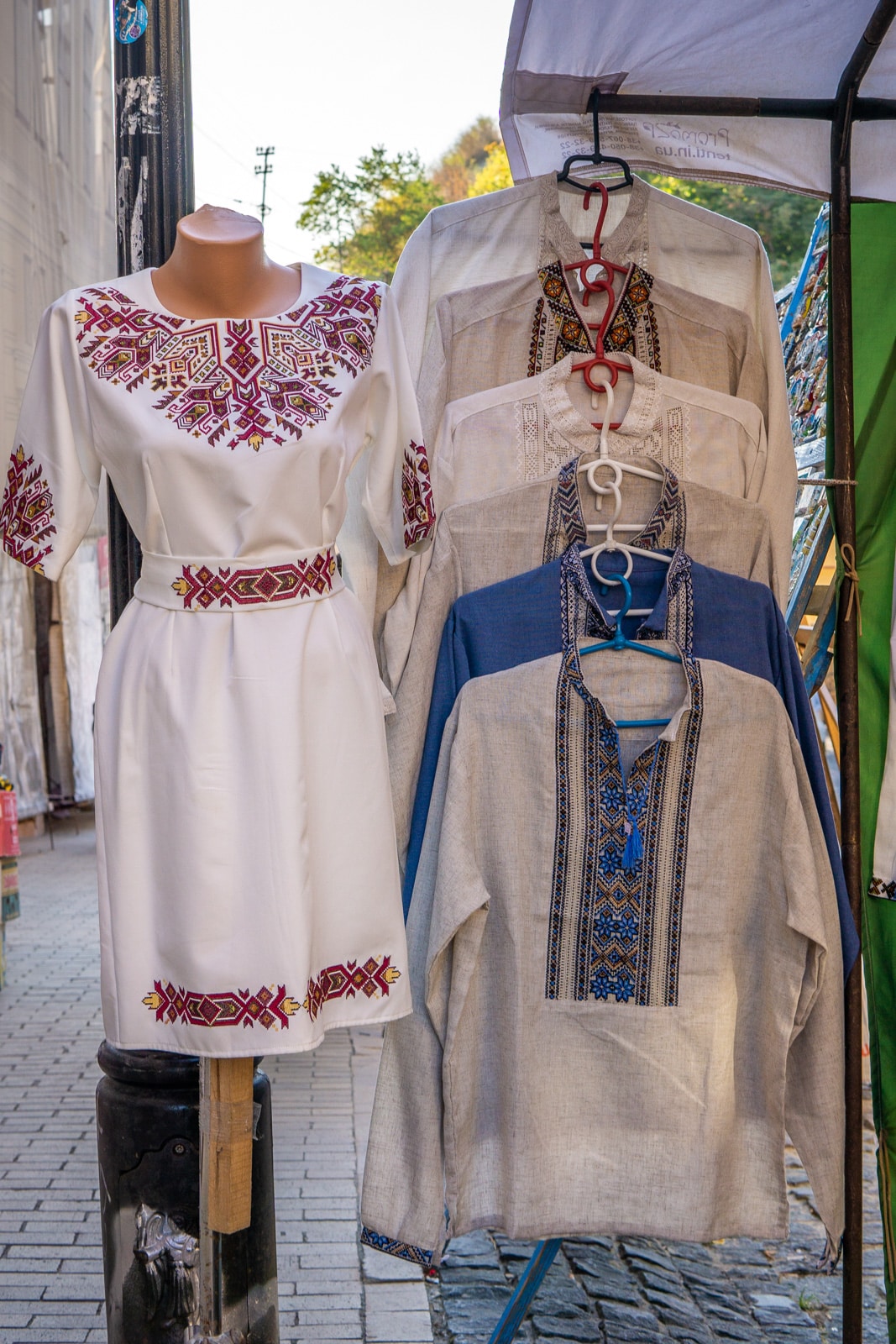
Traditional women and men’s clothes
Cossack culture is also visible. Cossack haircuts and boots are a common sight among Ukraine’s hip youth. Then there’s the music… oh, the music! One of the joys of walking around Ukrainian cities in summer is the many street musicians playing modern and traditional instruments on the street.
Hospitality in Ukraine
Ukrainians are also very hospitable. This is often displayed through small gestures, like blocking a closing metro door, or telling you your wallet is sticking out your pocket.
Once people are comfortable with you and trust you, you can be assured they will have your back. Knowing a bit of Ukrainian or Russian will go a long way, and don’t be surprised that when you ask for directions in broken Ukrainian a delighted villager will take you by the hand and show to the way (possibly with a few drinking stops in between).
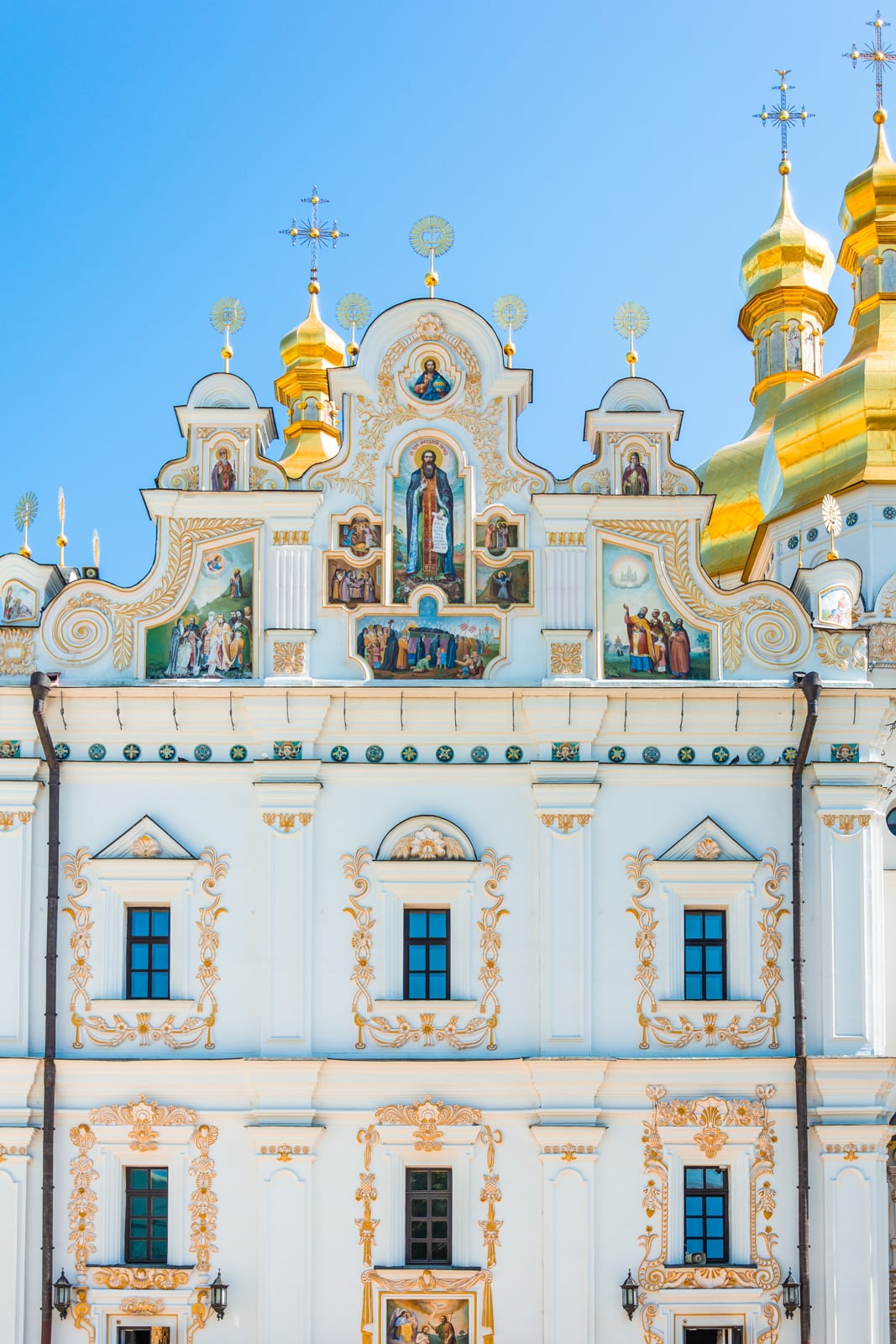
Kyiv Pechersk Lavra monastery
If you ever get invited to someone’s home, there are a few rules to have to follow. Always take off your shoes when entering someone’s house. Most people have special slippers or houseshoes for inside the house.
When sitting down for a meal, always say Bon Appetit, смачного (smachnoho, Ukrainian), orприятного аппетита (priyatnogo appetita, Russian) before starting your meal. To start eating without saying anything in considered rude, and you don’t want to be rude to your host.
On public transport, it’s also common for people to give their seats to pregnant women, old people, and people with children. I suggest you do the same when traveling in Ukraine.
Religion in Ukraine
Orthodox Christianity is by far the largest religion in Ukraine, followed by Catholicism. Minor Muslim and Jewish groups are scattered around the country. In Kyiv, you’ll see many Hare Krishna devotees in summer.
Although most people subscribe to a religion, young people in cities aren’t super serious about their religion. If you ask them about it, they’ll often confess—somewhat apologetically—that though they believe in God or spirituality, they’re not practicing. This holds especially true in cities such as Kyiv and Kharkiv. In villages, however, religion plays a large role in people’s day to day lives.
People are generally open when talking about their religion. Although they might not fully understand, people generally have no problems with atheism or agnosticism.

Typical cafeteria meal with borsch, sausage, and bread at Puzata Hata
Food in Ukraine
Ukrainian food is quite diverse, though not many tourists realize that.
The usual Slavic potato, vegetable, and meat staples are everywhere… but there is so much more! Ukraine’s pride is borsch, a beet soup found in many former Soviet states. But according to Ukrainians, borsch is originally Ukrainian… and the Russian variant sucks 😉
There are also many types of dumplings, called vareniki, which are delicious and cheap. Cafeteria-style vareniki places are found in each city.
Other Ukrainian staples include:
- Salo: pork fat
- Chicken Kyiv: chicken with butter inside
- Banush: popular in western Ukraine, made of corn grits, fried pork fat, and cheese
- Nalismiki: pancakes with topping rolled inside
There is also plenty of Tartar food to be found, influenced by Turkish and Central Asian cuisine. Think plov (rice dish), shashlik (barbecued kebabs), and fresh salads.
In cities, you’ll find plenty of restaurants serving all sorts of food in every price range. For the cheapest options, head to cafeterias such as the Puzata Hata chain.
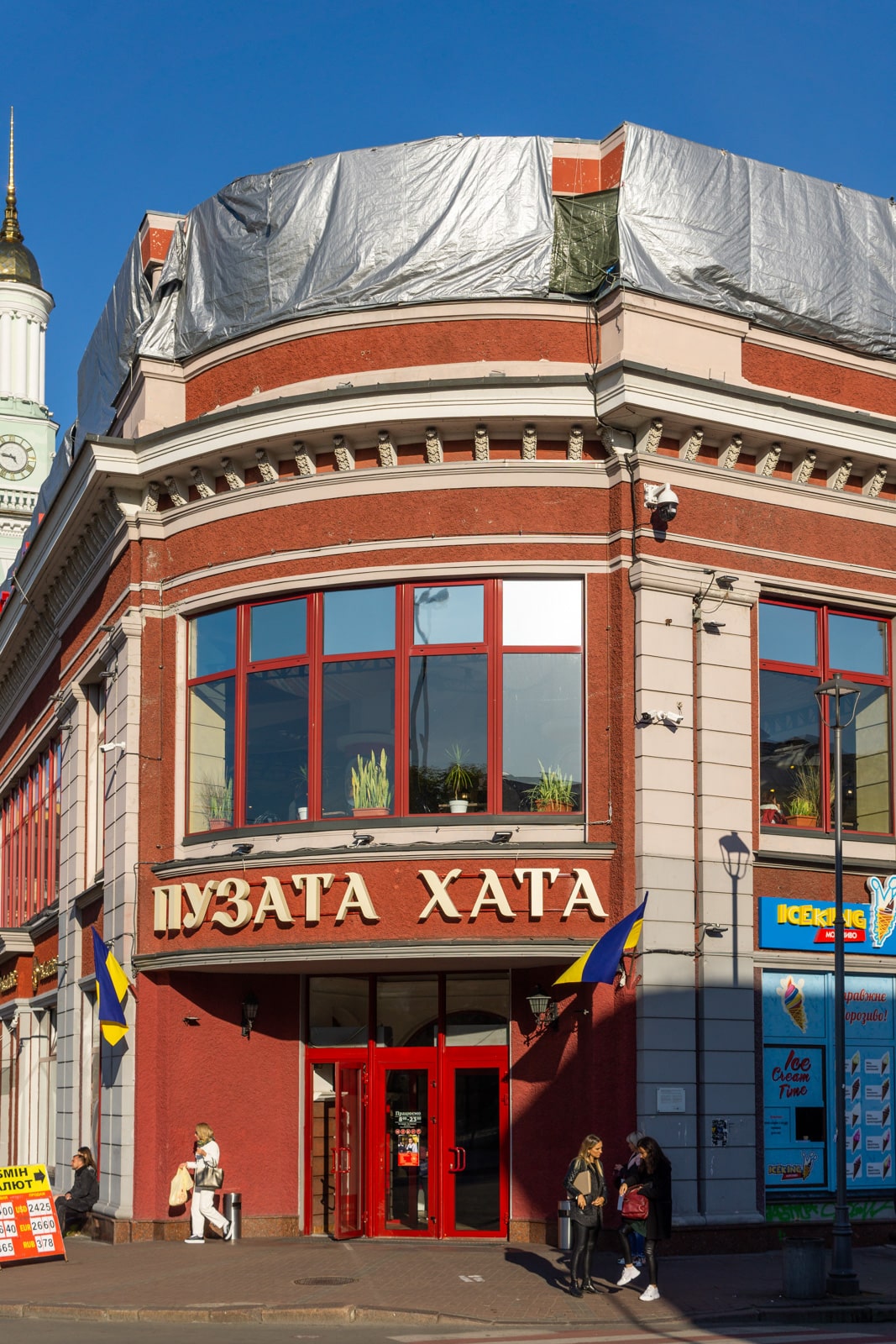
A Puzata Hata cafeteria
Vegetarians and vegans in Ukraine
Vegetarians rejoice: it’s easy to go meatless in Ukraine!
Although several staples include meat, it’s almost always possible to fill up on veggies and starches at local cafeterias. In big cities, you can find plenty of vegetarian and vegan restaurants. Most places have vegetarian options on the menu.
Big cities have several vegan restaurants, but vegans might have a harder time in villages. Grilled vegetables are almost always an option, but proteins are harder to come by. Beans do make an occasional appearance, and Georgian food often contains beans (known as lobia). Just make sure to learn how to say no cheese, no yogurt, etc. Ideally, before someone cooks for you!
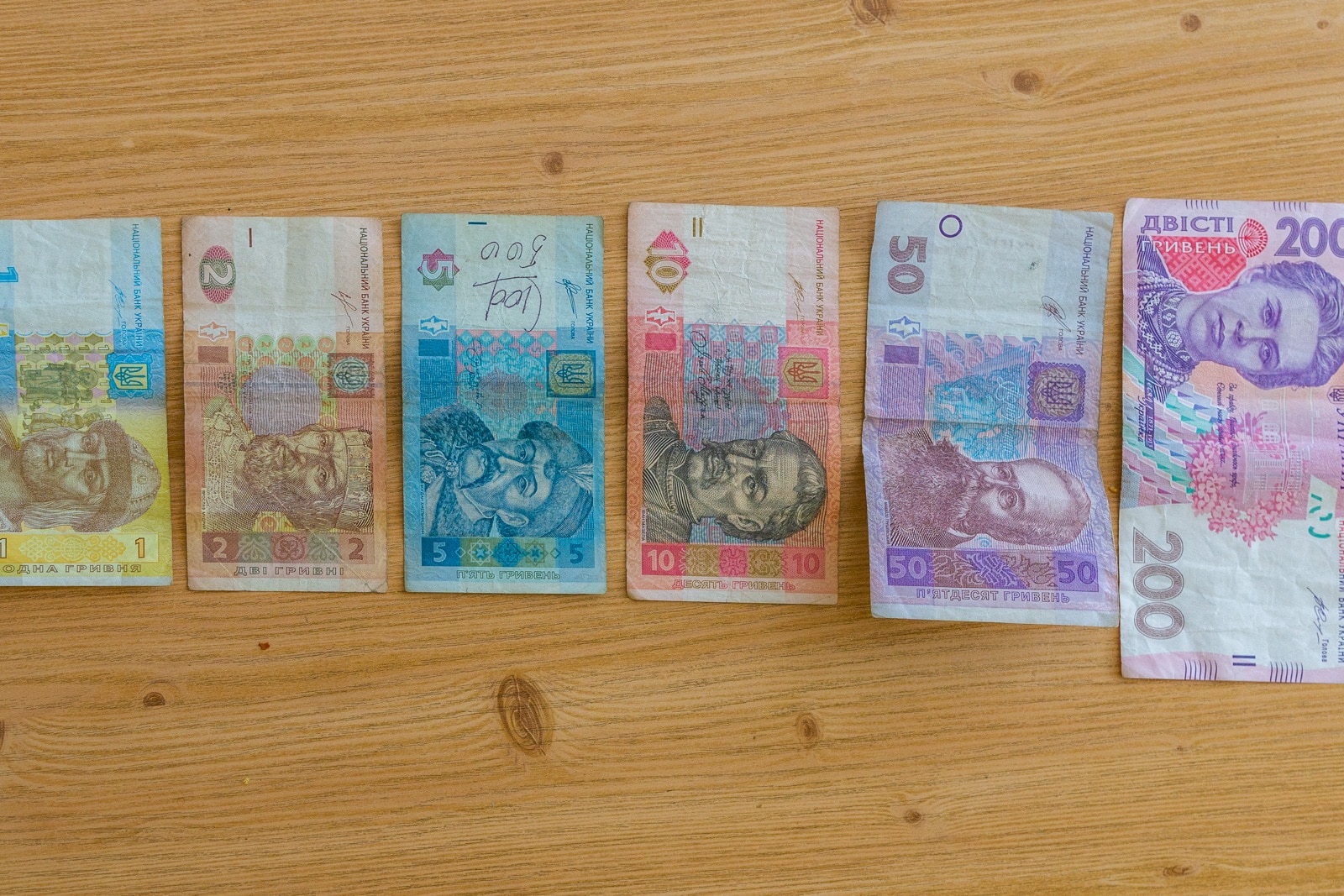
Ukrainian hryvnia
Money in Ukraine
Ukraine’s national currency is the hryvnia (UAH). There are 1,000, 500, 200, 100, 50 20, 10, 5, 2 and 1 hryvnia notes, and a variety of coins that even now, after 6 months in the country, confuse me.
Most ATMs in Ukraine take international cards. However, several only allow small withdrawals or charge a withdrawal fee. In my experience, Ukrsibbank is your best bet for larger withdrawals without withdrawal fees. Money changers are everywhere; shop around for the best rate.
Tip: When withdrawing money from ATMs, many will ask if you want to use their “guaranteed exchange rate”. This rate is much worse than the rate your bank usually gives. If you’re asked by the ATM, say no. Choose “use payment system rate” instead.
It’s common to see people use Apple or Google Pay for anything from a small cup of coffee to a new laptop. All major cards are accepted, and even my Dutch Maestro card works everywhere. All terminals are pay-pass ready; this is the preferred mode of payment.
Cost of travel in Ukraine
After the annexation of Crimea and the war in the east, the Ukrainian hryvnia devalued significantly. Dropping from roughly 8 UAH to the dollar to around 25 UAH to the dollar. Painful as this was for Ukrainians and the Ukrainian economy, this does mean Ukraine is relatively cheap to travel in for people who have euros or dollars. For a more detailed look, check out my Ukraine budget report.
Average costs for travel in Ukraine (2020)
- One night in a hostel in Kyiv – 150 to 300 UAH (US$6-12)
- Airbnb in Kyiv – 600+ per night ($25+)
- A beer or a cider in a bar – 30 to 60 UAH ($1.25-2.50)
- Dinner at a cafeteria – 50 to 150 UAH ($2-6)
- Cocktails in a fancy cocktail bar – 150 to 300 UAH each ($6-12 each)
- Dinner in a sit-down restaurant – 100 to 300 UAH ($4-12)
- A six-hour train journey – 150 to 400 UAH ($6-17)
If you travel slowly, stay in hostels, eat in cafeterias, and get drinks from the supermarket before you go out, you can easily backpack in Ukraine for about $20 – 25 a day.
So as you can see, travel to Ukraine is definitely cheap. But when visiting Ukraine, please don’t rave about how cheap everything is. It might be cheap for you, but many Ukrainians are struggling and saw their purchasing power disappear from one day to the next. Be sensitive. It might not seem to when walking around Kyiv or chilling on the beach in Odesa, but the average wage in Ukraine is still only about $500 per month, making it one of the poorest countries in Europe.
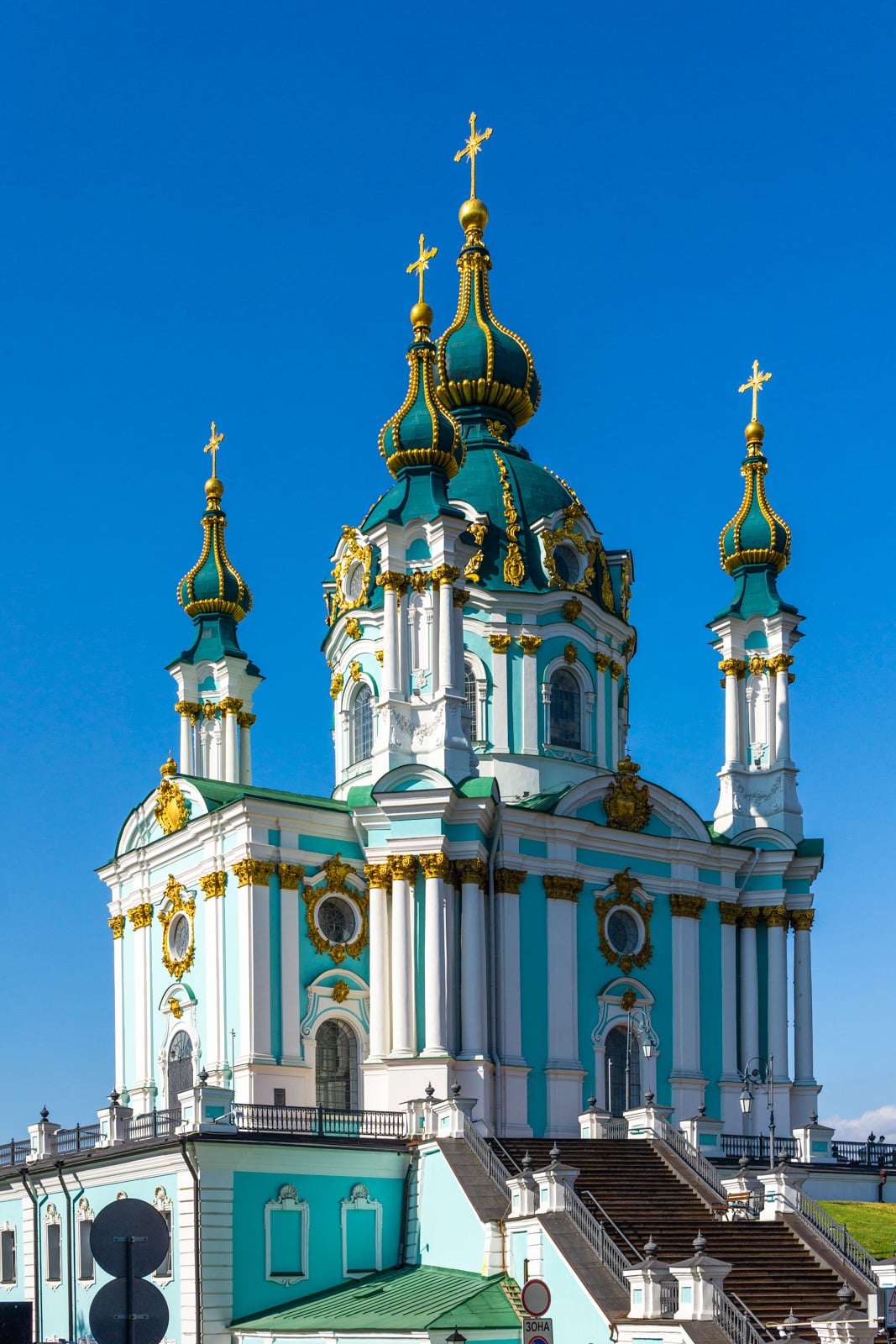
Andrew Church in Kyiv
Visas for Ukraine
Most people from Europe and North and South America can travel to Ukraine for 90 days in a 180-day period without needing a visa.
A select group of Asian nationalities, as well as Australians, need to apply for an eVisa.
Citizens from most African and Middle-Eastern countries require a visa to visit Ukraine.
Get more information about visas for Ukraine here.

Tram in the city
Entering and exiting Ukraine
You can enter and exit the country in several ways:
By air
Kyiv, Lviv, Kharkiv, Odesa, and several other cities have international airports with daily flights from all over the world.
By land
Ukraine shares many land borders with multiple countries. These include:
- Moldova: Technically, you are entering the breakaway republic of Transnistria first when crossing from Ukraine to Moldova. Many tourists make a quick stop in Tiraspol before going on to Moldova proper. Most people can get a visa for Moldova at the border. The best way to go to Moldova is by train or bus from Odesa.
- Belarus: There is a train running from Kyiv to Minsk, but make sure to get your visa in advance. The Belarus visa on arrival can only be obtained when you fly into Minsk.
- Russia: There are several border crossings between Russia and Ukraine. Except for the ones in the Donetsk and Luhansk region, they operate regularly. There are trains and buses between Russia and Ukraine.I crossed the border between Belgorod and Kharkiv in mid-2019 and it was a straightforward crossing.
- Several EU countries: Poland, Hungary, Romania, and Slovakia. Crossing these borders is relatively straightforward, but it can take a long time, especially when exiting Ukraine.
By Sea
It’s possible to travel to Ukraine by ferry from Batumi in Georgia, Haydarpasa in Turkey, and Varna and Bulgaria. Prices vary but are around $100 per passenger. Check out the Ukrferry website for more info. Another company offering services from Bulgaria and Georgia to Ukraine is Navbul.
Ferries dock at a Ukrainian city called Chornomorsk. Chornomorsk is close to Odesa, and it’s easy to find a bus or marshrutka to Odesa from Chornomorks.
Entering and exiting the country is pretty straightforward. There are no entry or exit forms to fill out, and there are few if any questions asked at the border when entering or exiting Ukraine.
Transport in Ukraine
Ukraine is a vast country; getting around can take a while. Luckily, Ukrainian Railways connects most of the country. There are also long-distance buses to almost any city in Ukraine. You can always take local marshrutkas (minibus) to get to smaller towns throughout Ukraine.
Trains in Ukraine
Trains are my favorite way of getting around Ukraine. If you travel to Ukraine, you’ll need to take a train at least once. Trains are generally clean, convenient, and affordable. If you’ve been to other former Soviet states, Ukraine’s train system will feel familiar.
There are several types of trains with several classes. The fastest trains are Intercity (IC) and Intercity+ (IC+) trains, and “transformers”. Night trains are usually slower.
Prices are competitive at the lowest class but can get quite expensive for the higher classes. Try to book a few days in advance in the summer season, especially when going to the mountains.
Buying train tickets in Ukraine
It’s easy to buy tickets for trains in Ukraine. Go to the official Ukrainian Railways booking website to buy tickets online. The website is in English, and it accepts international debit and credit cards.
Most of the time, your ticket will be directly sent to your email address. Show the PDF to the conductor on your mobile phone—no need to print anything!
In some cases, however, you’ll get something called an “order form”. This form is not a valid ticket. To get a valid ticket, show the order form at any train station ticket booth and the clerk will print a ticket for you. Both the website and the email including the order form will clearly state that this is just an order form—in English—so it’s hard to make a mistake.
Emails regarding train tickets are in English, but the tickets themselves are in Ukrainian. The email will say in English in which wagon you are sitting, and on which seat, but it’s helpful to be able to read Cyrillic to figure it out from just the ticket. The word for wagon is вагон, and the word for seat is місце.
For more information about train travel in Ukraine, check out this useful guide.
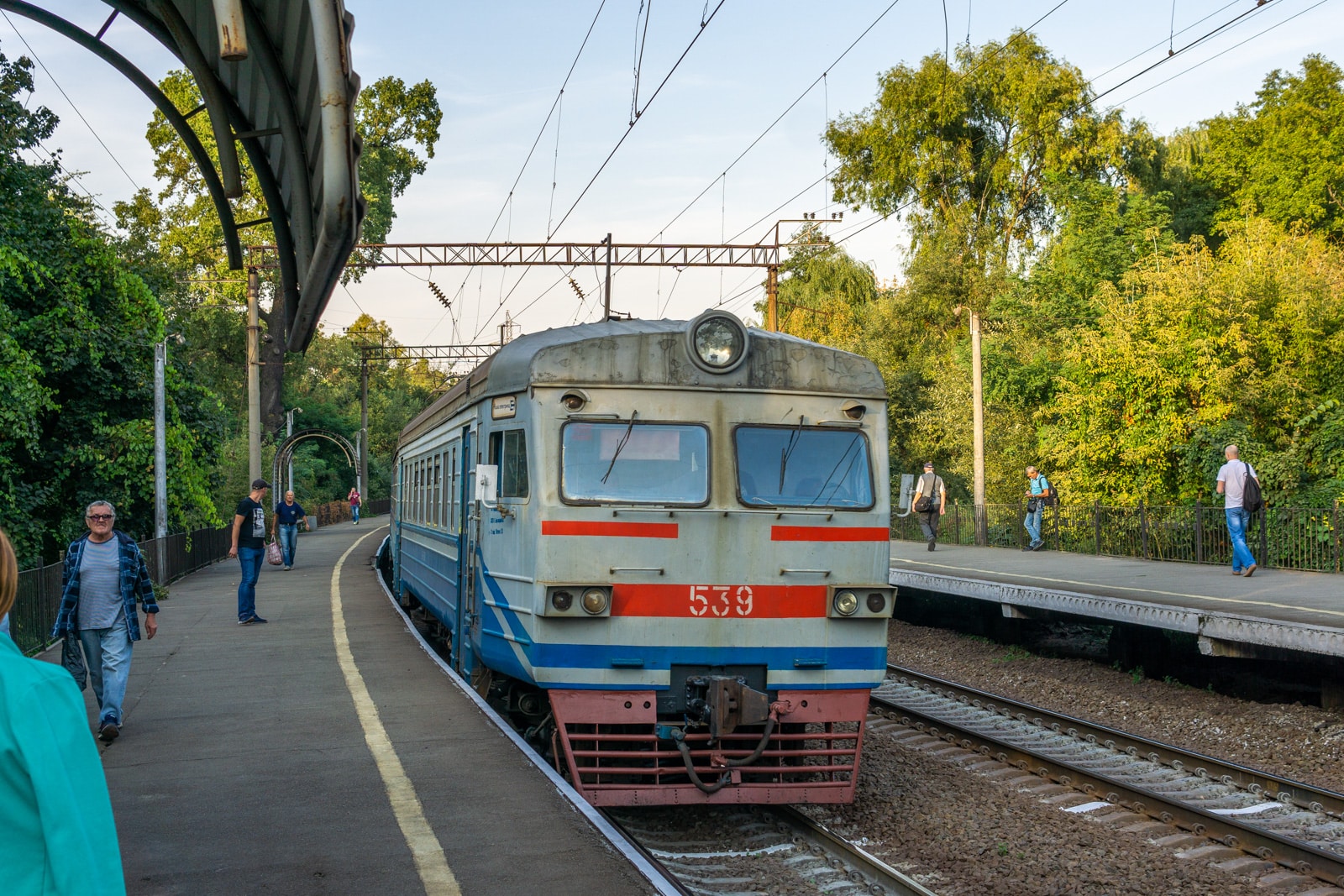
Buses in Ukraine
Buses in Ukraine range from comfortable long-distance buses with AC and reclining seats to Soviet monstrosities that shouldn’t be allowed on the road.
For the more comfortable buses, it makes sense to book tickets ahead of time. Usually, you can just show up at the bus station and get a ticket there. This holds especially true for short-distance buses, which usually go hourly.
Bus stations can be a confusing affair, especially if you can’t read Cyrillic and don’t know any Ukrainian or Russian. Don’t be afraid to approach people for questions; even if they don’t speak English, people will often try to help you regardless of the language barrier.
Some cities have several bus stations. Check beforehand which bus station you depart from.
Marshrutkas in Ukraine
Marshrutkas, minibusses, are used for short trips between close-by villages, towns, and cities. They’re not particularly comfortable (unlucky passengers have to stand) and not particularly fast. Luckily, they’re cheap, and in the more remote parts of the country they’re often the only way of getting around.
Transport in Ukrainian cities
It’s generally easy to get around in Ukrainian cities. Big cities such as Kyiv and Kharkiv have good metro systems. Most cities have a combination of buses, trams, trolleybuses, local trains and marshrutkas to get you around. Google is your friend when trying to figure out how to get from A to B.
In most cases, you pay the driver when you get on the bus/tram/whatever. Don’t worry if you get in at the back and it’s packed (likely). Give your money to the person in front of you, and watch it magically make its way to the driver. Don’t be surprised if other people ask you to do the same.
Local transport within cities is usually 7 or 8 hryvnia, regardless of destination. Don’t expect drivers or ticket collectors to speak English, although in some buses in the popular cities destinations will be announced in English.
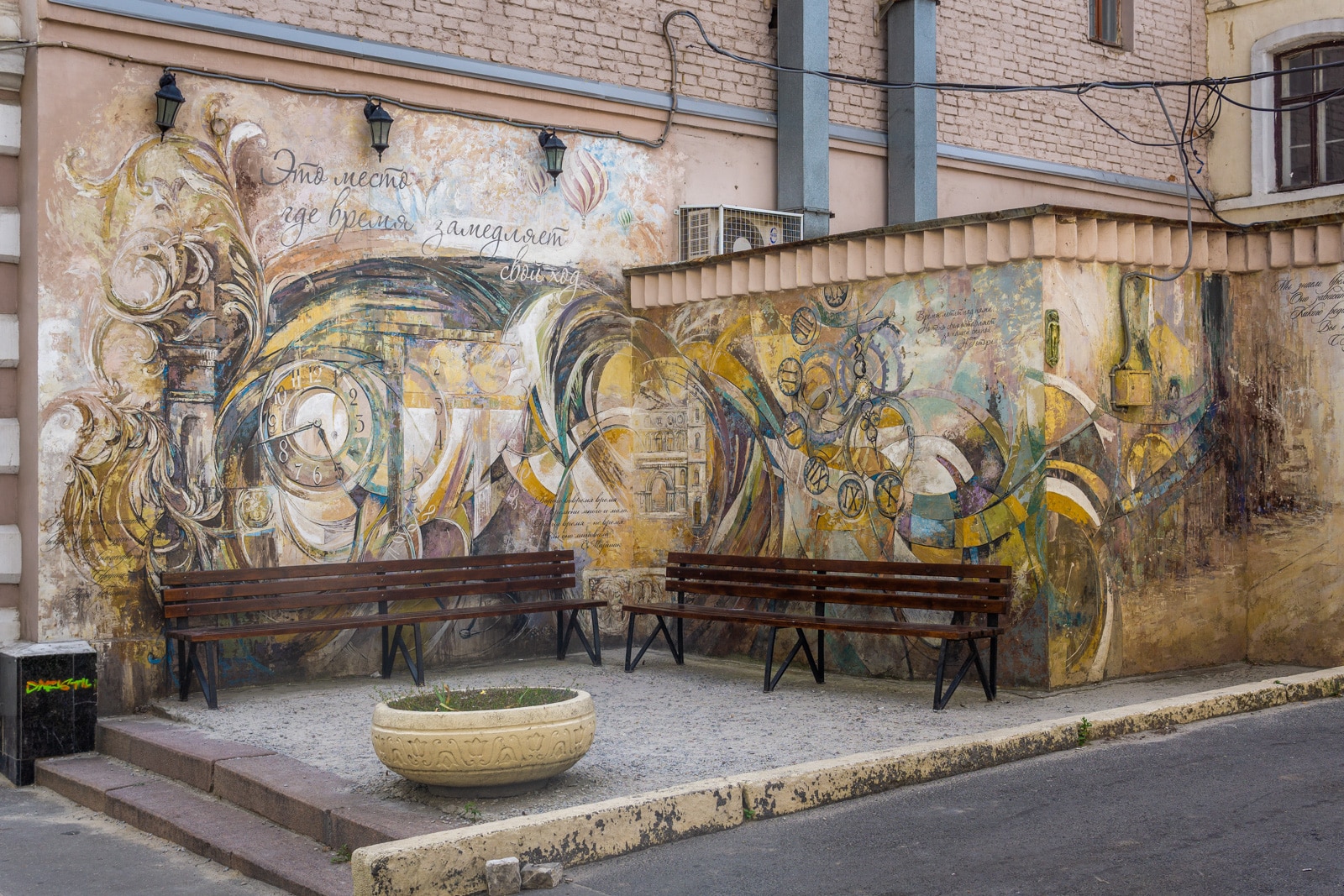
Street art in Kharkiv, Ukraine
Safety in Ukraine
According to the 2019 Global Peace Index, Ukraine is among one of the most dangerous countries in the world, standing at 150 of 163 countries. However, this headline number doesn’t tell the full tale.
In 2014, Russia annexed Crimea, and a war started between Russian backed separatists and the Ukrainian military in the eastern regions of Donbas and Luhansk Oblast. More than 10,000 people have died since the conflict started in 2014.
This war, which has been at a stalemate for some time, only affects the far eastern part of Ukraine, where travelers can’t visit. The rest of the country, including some areas within the Donestk Oblast, is quite safe to travel.
An example: on my first visit I went to Slovyansk (where the war started) and Kramatorsk, only 60km from Donestk city. It was perfectly safe then, and my local friends say the situation has only improved.
This is not to say there are no dangers at all… but the dangers you’ll face in Ukraine are the same dangers you’ll face everywhere. Pickpocketing attempts in busy transport hubs are not uncommon, and I’ve seen a drunken bar brawl or two. But in general, Ukraine is a safe country for travelers. I’ve seen more people telling others to watch their belongings on the metro than I’ve seen pickpocketing attempts.
As long as you exercise regular caution—the same caution you would exercise in American or British cities, for instance—Ukraine is a safe country to travel in.
However, it is always important to be well insured when traveling. I recommend using Word Nomads for your travel insurance when visiting Ukraine.
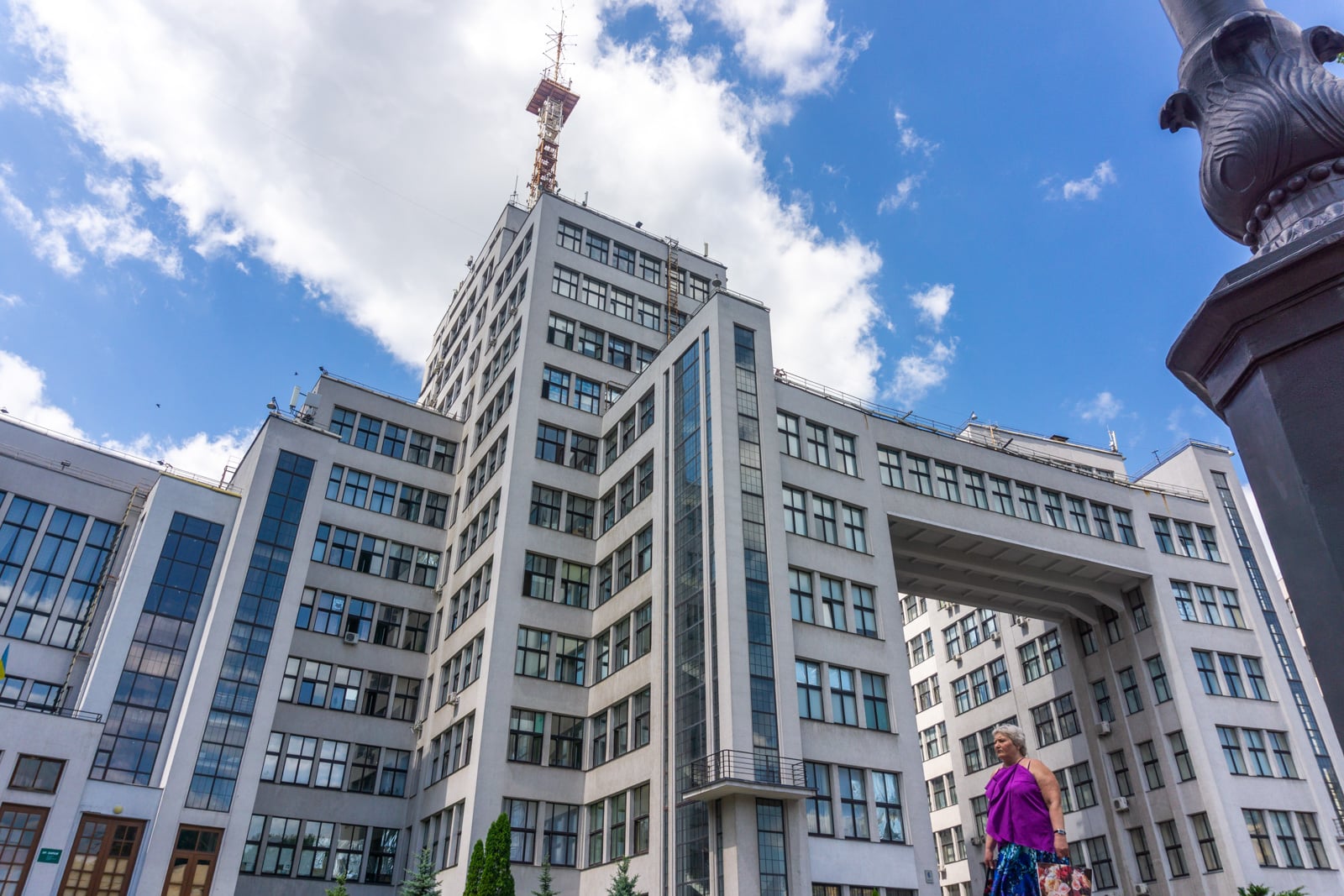
The Derzhprom building in Kharkiv
Connectivity in Ukraine
Ukraine is a well-connected country, with wide 4G coverage and cheap data to go around. There are three major mobile operators in Ukraine:
- Kyivstar (Київстар)
- Vodafone
- Lifecell
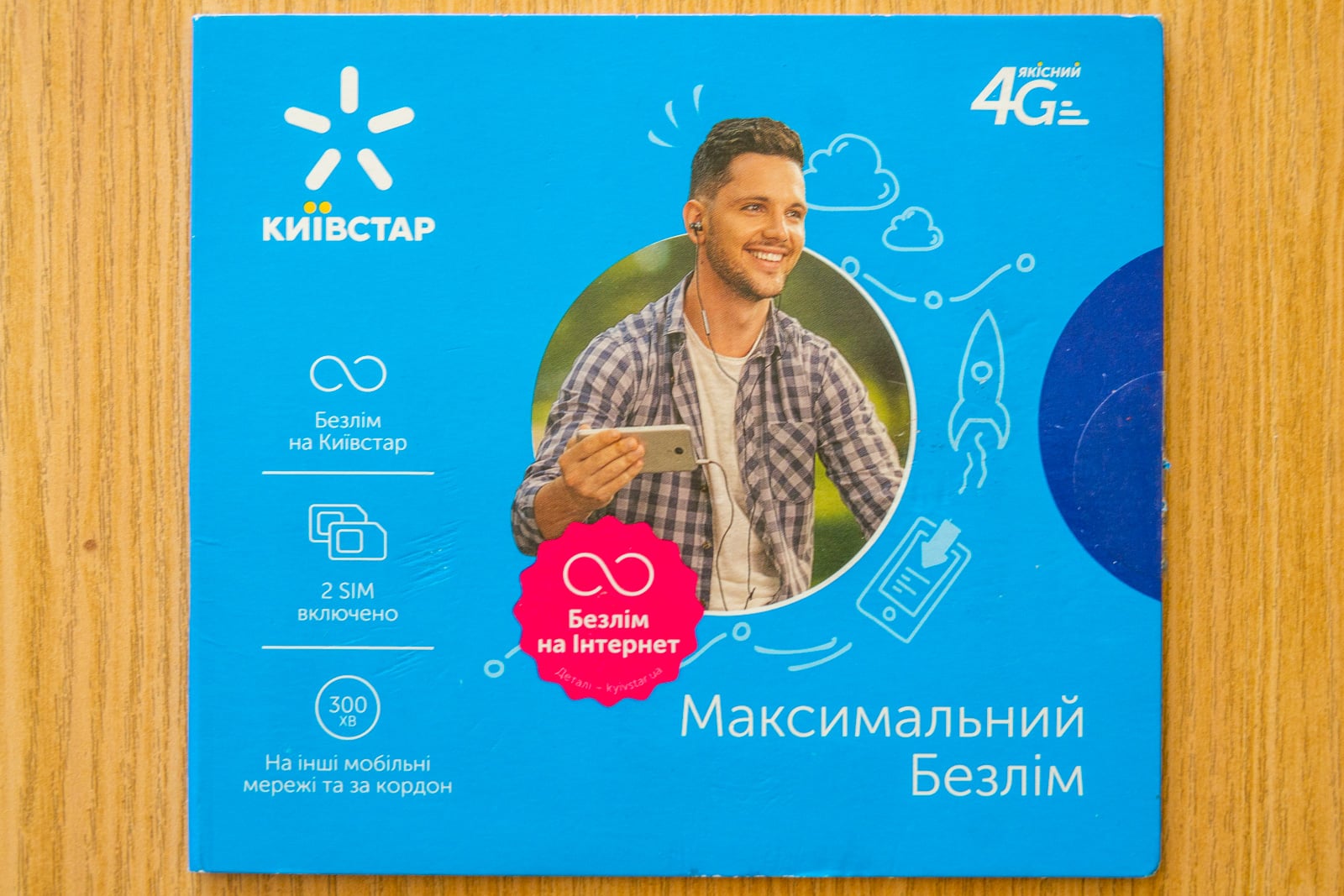
My Kyivstar SIM card
Kyivstar is the largest operator and has the widest coverage, covering around 70% of Ukraine’s population. After that comes Vodafone and Lifecell. There is no registration required to get a SIM card in Ukraine. It is wise to bring a passport, though I’ve never been asked for mine.
Rates are competitive, but since Kyivstar has the highest coverage, most travelers opt for Kyivstar. 3GB of data with Kyivstar is 75 hryvnia (US$3), where 4GB of data is 90 hryvnia with Vodafone.
For information about how and where to get a SIM card in Ukraine, check out this useful guide.
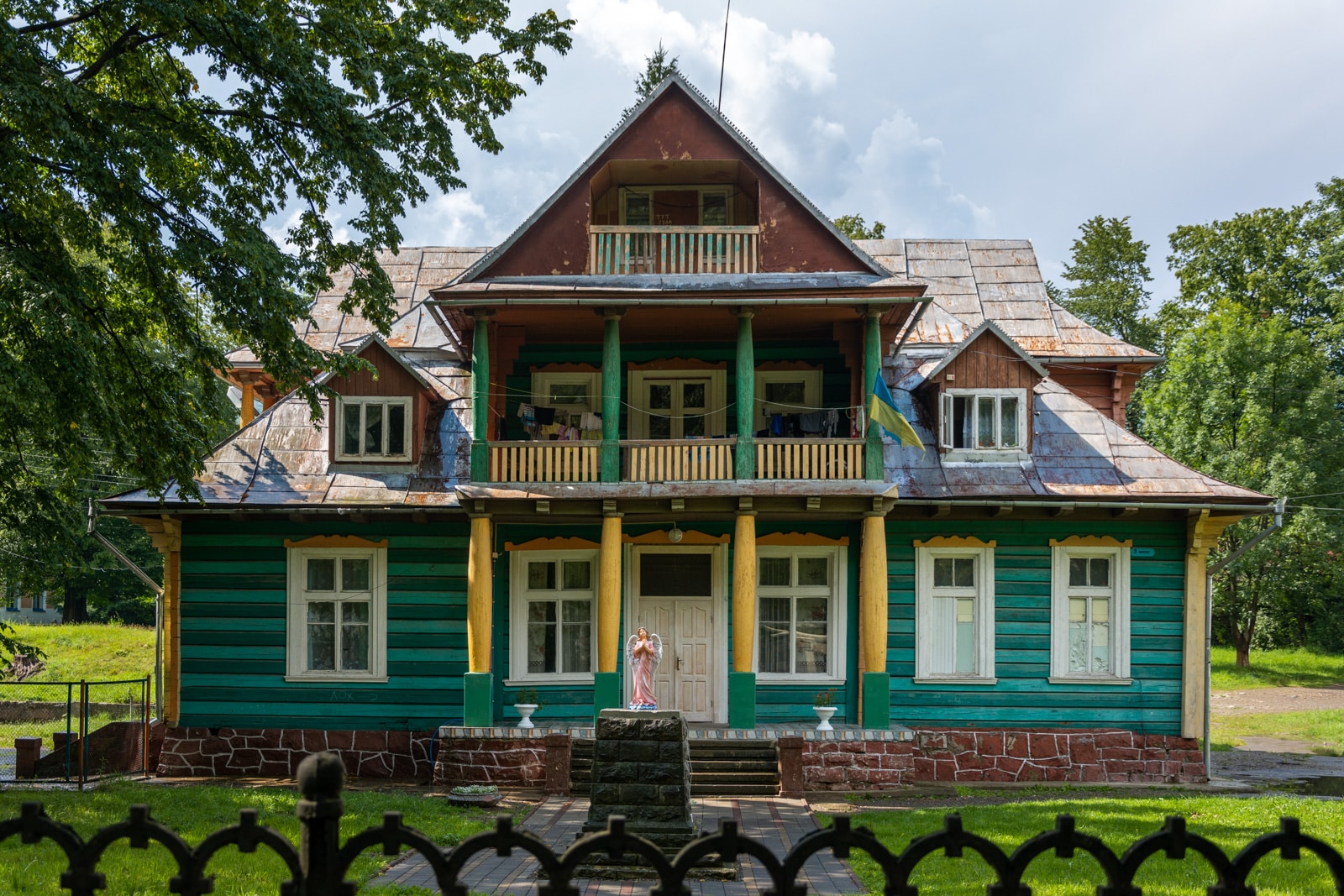
A particularly pretty Carpathian house in southwestern Ukraine
Places to visit in Ukraine
Ukraine is best visited between spring and fall. Winter gets depressingly cold, and summer temperatures can soar to over 30 °C. The Carpathians are best visited in summer.
Below are a few recommendations for places to visit in Ukraine, based on activities available. These are just a handful of the most common places to visit, and Ukraine offers much more. But if you’re short on time and want to see the highlights, these are some of the best places to visit in Ukraine.
Kyiv
Kyiv is the capital of Ukraine, and oh, what a city it is! Lots of parks, cool bars, quaint architecture, restaurants and cafes to satisfy any palate, and many other things to do—Kyiv is one of my favorite cities in the world. I recommend anyone visiting Ukraine to visit Kyiv for at least three days. Check out my Kyiv itinerary for more on this amazing city.
Kyiv is also the best place to arrange a tour to Chernobyl.
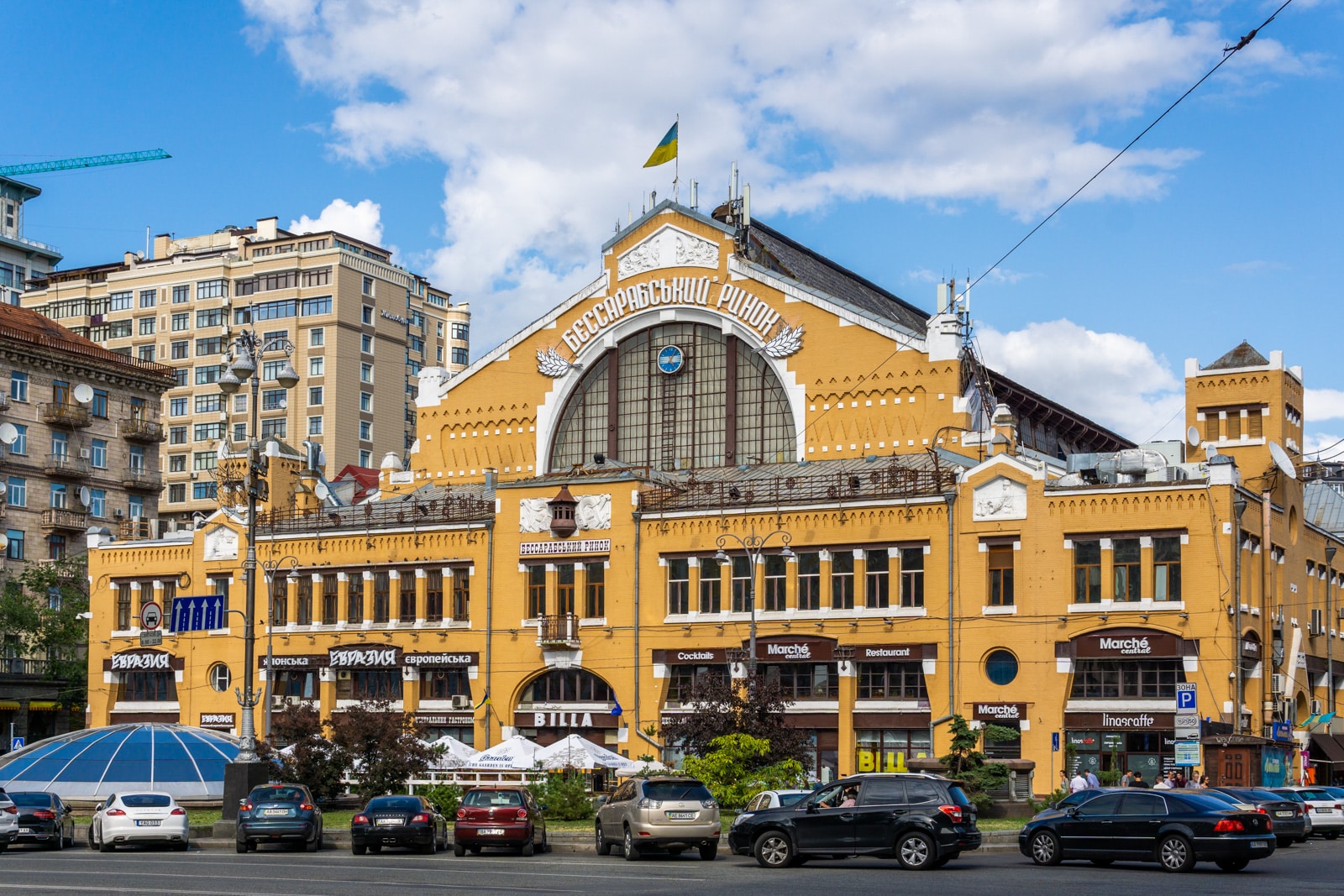
Bessarsby Market in Kyiv
Western Ukraine
Lviv
Lviv, close to the Polish border in the west, is the heartland of Galician culture in Ukraine. Proudly nationalistic, Lviv considers itself more Ukrainian than any other city in the country. The city itself is small, with most bars, restaurants, and activities centered around central Rynok Square.
Lviv overflows with quirky bars and restaurants, and houses some amazing architecture more reminiscent of Vienna than Soviet cities. It’s a lively city that can feel overly touristy at times, but is simultaneously lots of fun and incredibly pretty.
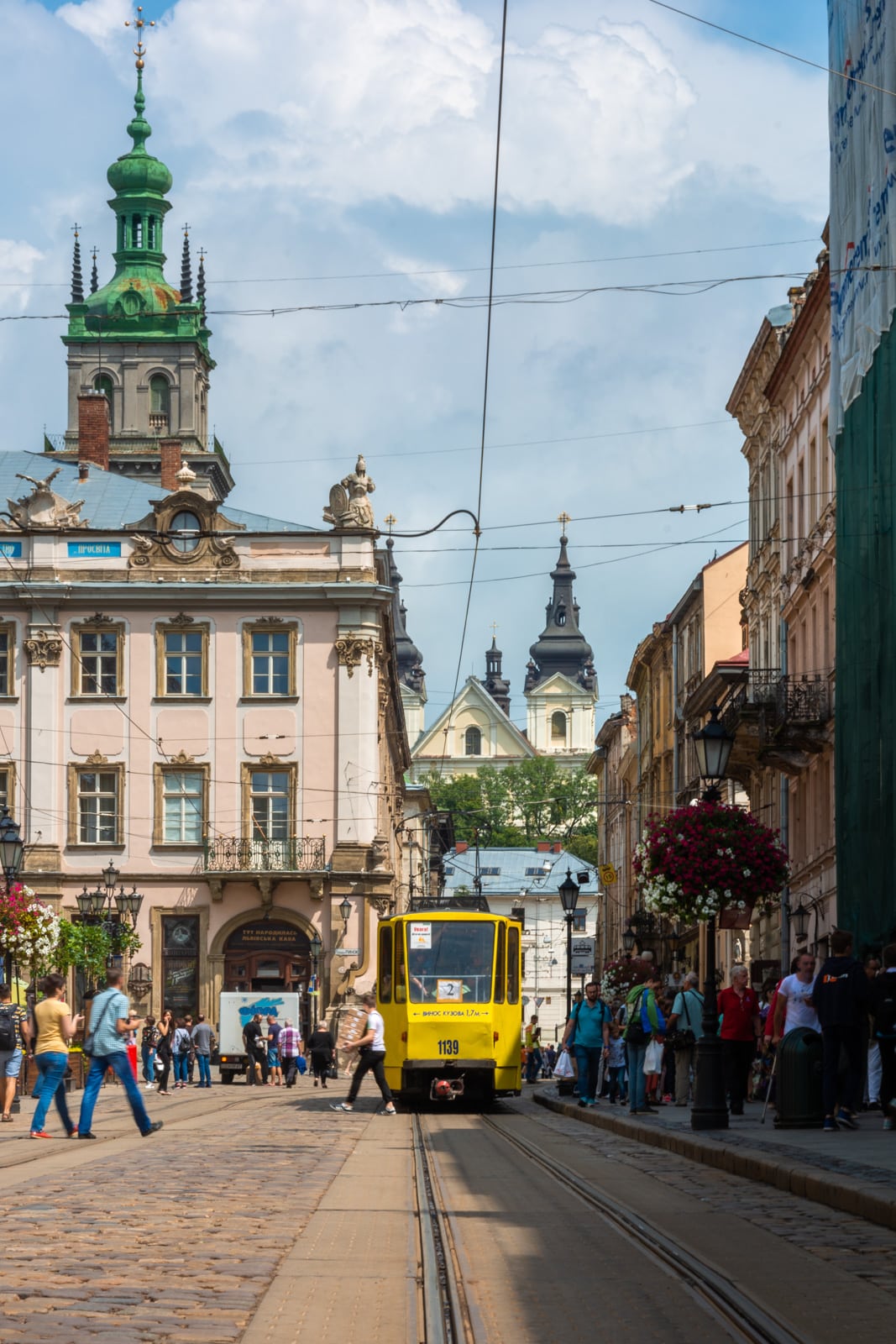
Lviv city center
Carpathian mountains
The Carpathian mountains in southwestern Ukraine offer relief from the summer heat. Dotted with small villages and a few cities, the Carpathian area is great for those wanting to get lost in nature and rural life.
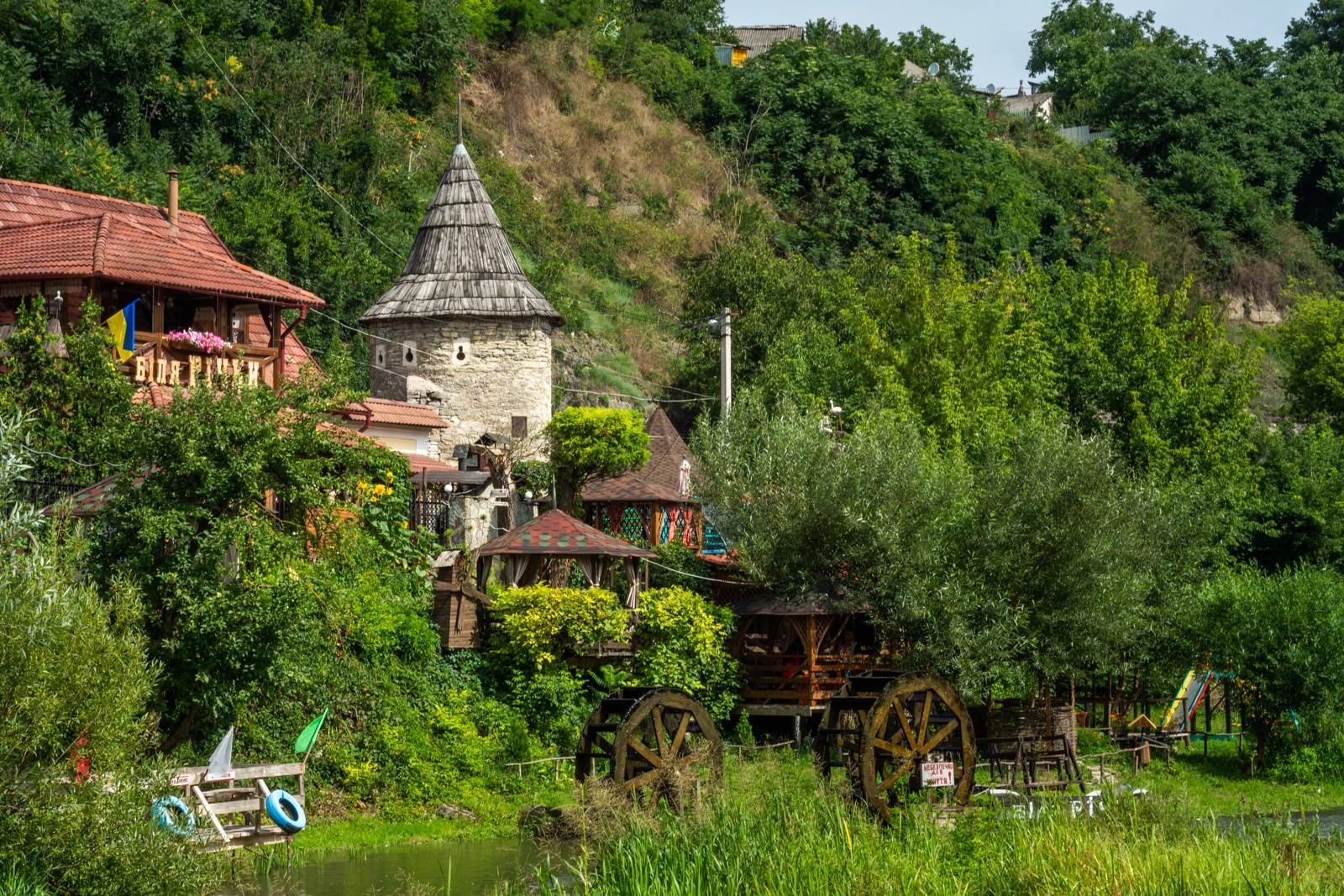
Carpathian village
Uzhhorod
This city on the border with Slovakia is often overlooked by tourists. But with its interesting history, medieval fort, and charming, laid back vibe, it’s worth visiting for a day or two. Uzhhorod can easily be combined with a loop around the Carpathians.
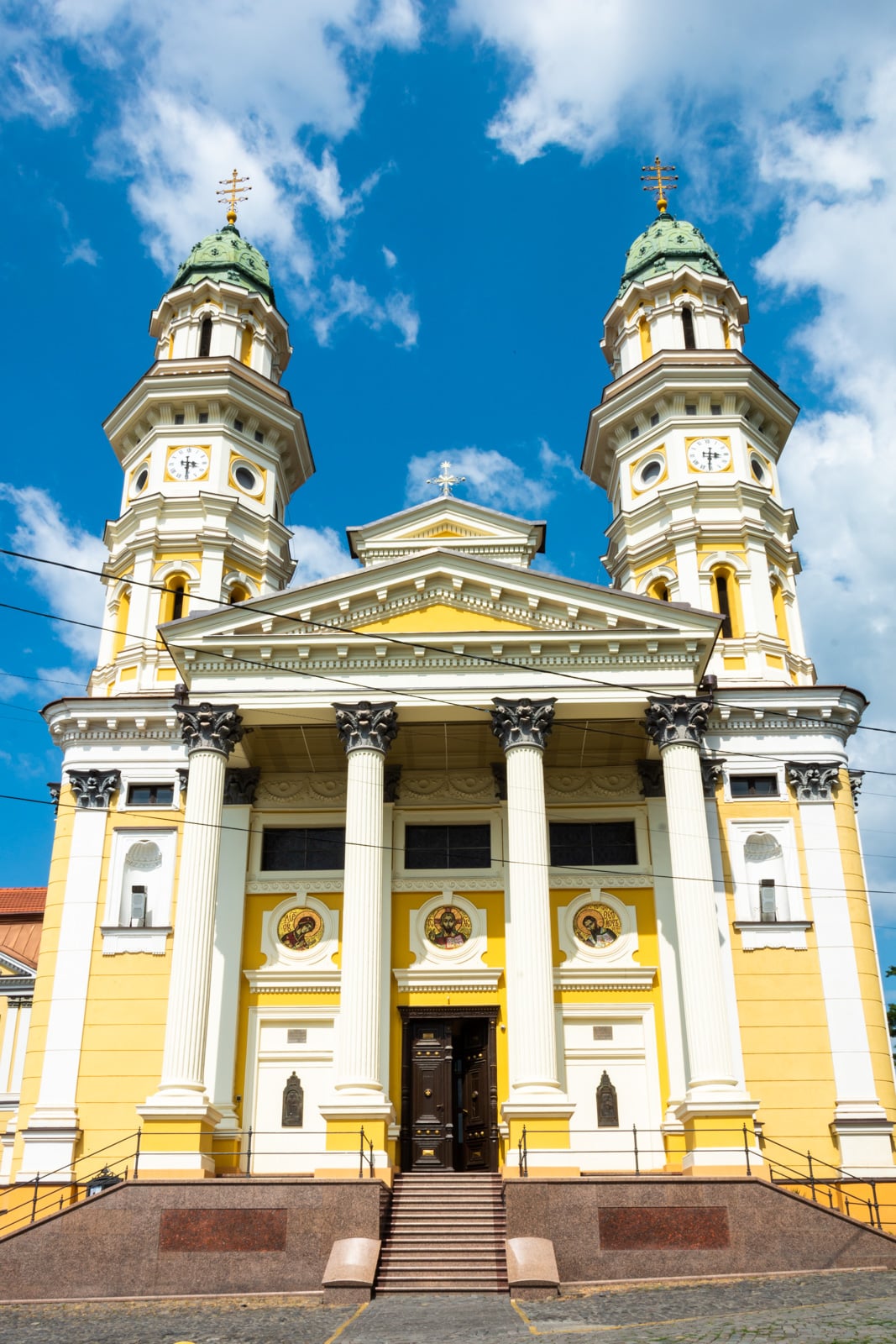
Church in Uzhhorod
Southern Ukraine
Odesa
Most people have heard of Odesa, Ukraine’s premier beach resort since Crimea is no longer accessible to most. Popular with Turkish and local tourists alike, Odesa bumps in summer but gets crowded. Like… really crowded. The innercity is charmingly Italian-like, with colorful houses and cute cafes.
Most people go to Odesa for beaches and parties. Good fun if you’re into these sorts of things, but if you want a more relaxing beach experience, try one of the small towns around Odesa instead.
Eastern Ukraine
Kharkiv
Overlooked by most tourists, Kharkiv is one of the most underrated cities in Ukraine. Its big student population means there’s always something going on. Aficionados of Soviet architecture can eat their hearts out. Kharkiv houses some cool bars and people are friendly and open to hanging out.
If you plan to enter Russia from Kharkiv, or plan to enter Ukraine at this border from Russia, check out my guide to crossing the border between Belgorod and Kharkiv.
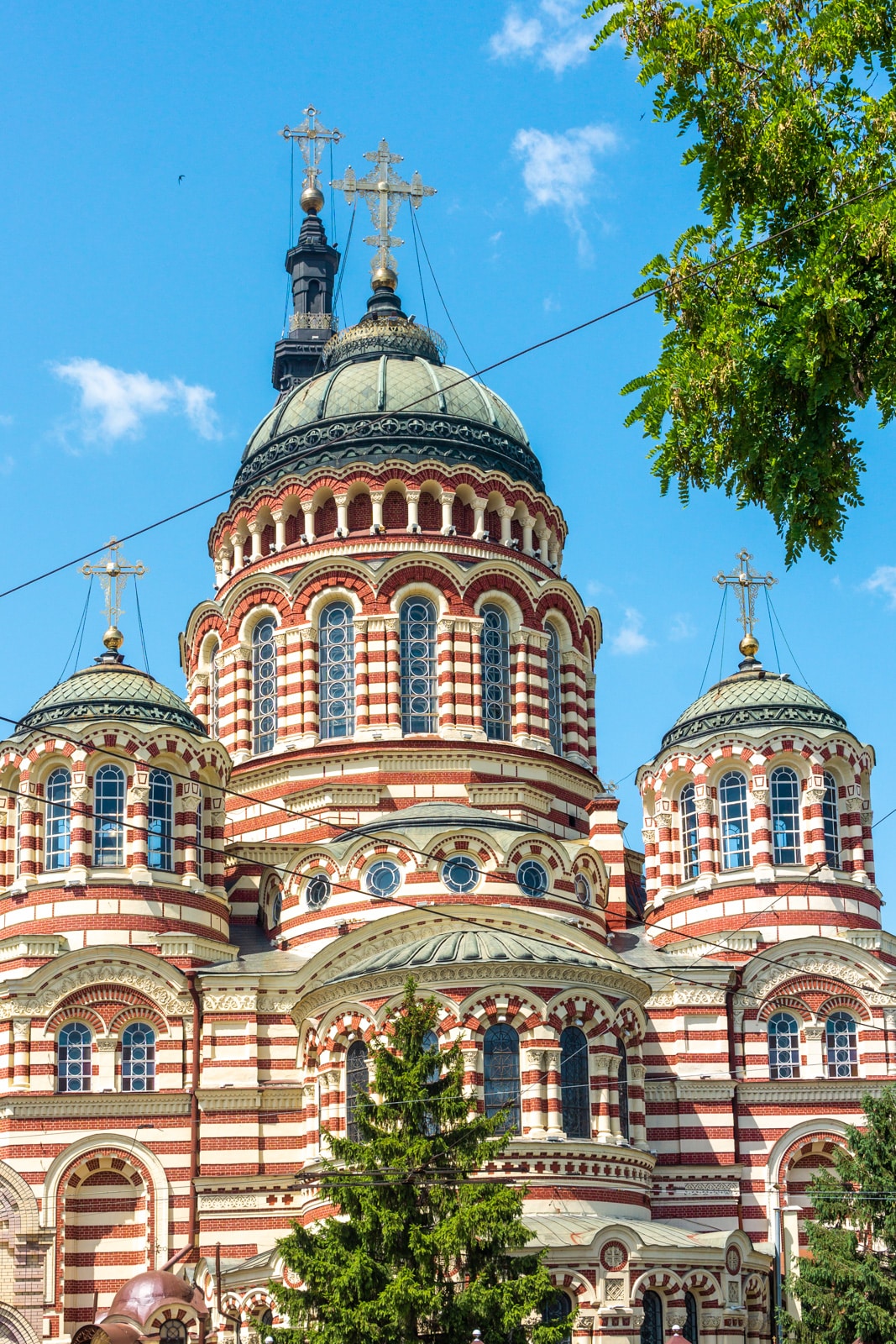
A Byzantine church in Kharkiv
Zaporizhzhia
If interested in Ukraine’s Cossack history, you have to visit Zaporizhzhia. The city is home to Khortytsia Island, a former Cossack stronghold within the Khortytsia National Reserve, and the open-air Museum of Zaporizhian Cossacks. There’s also a pleasant park along the river, and a museum dedicated to jet engines and motorbikes.
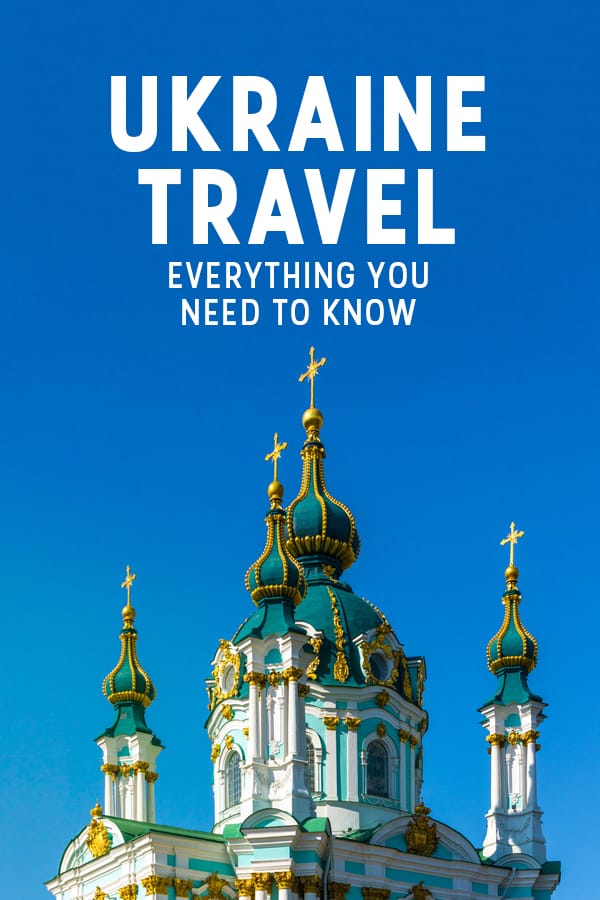
Was this helpful? Pin it!
So concludes my Ukraine travel guide. Have more questions I didn’t answer? Let me know in the comments!
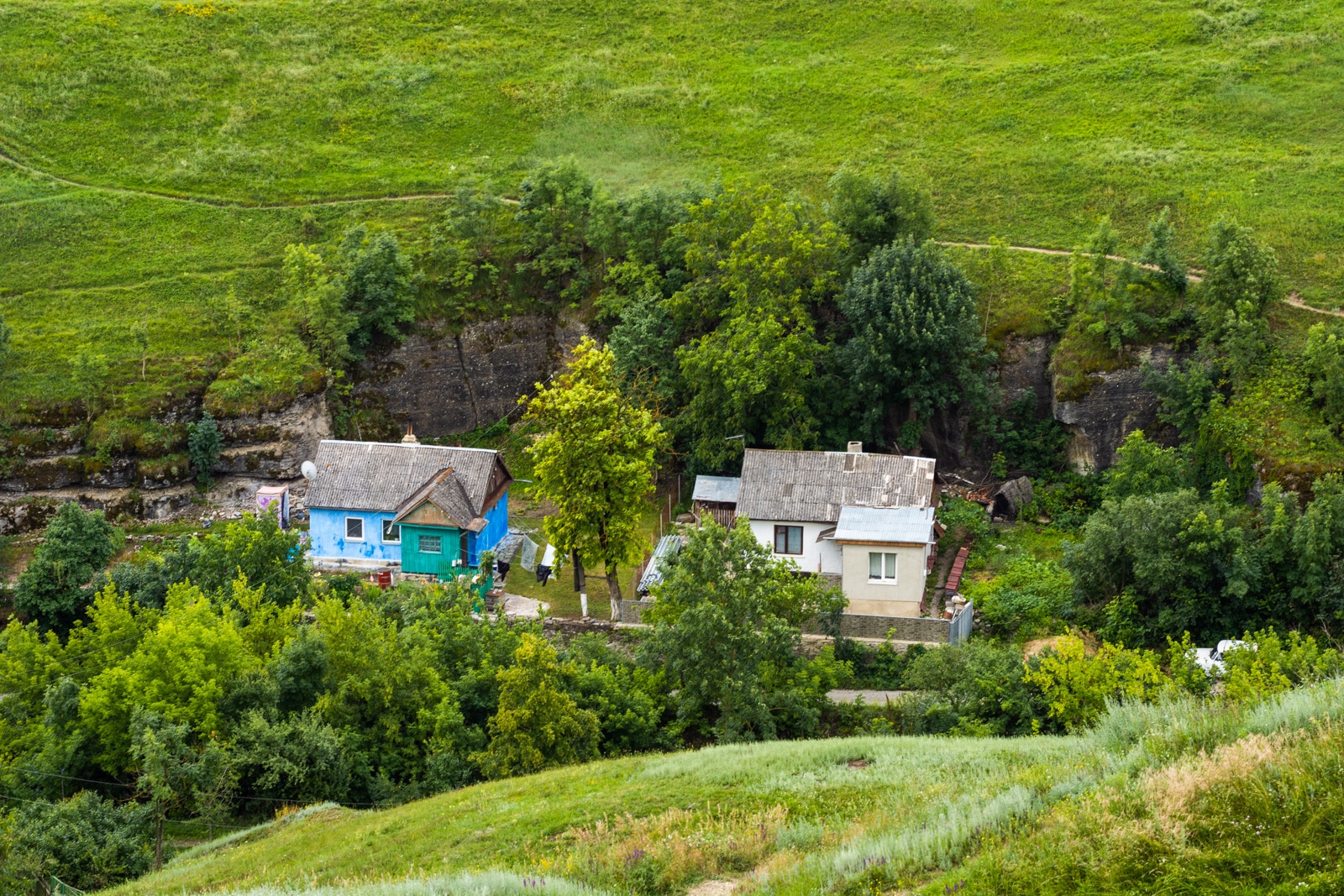


Hello, I read your blog and it was very informative. I did have some questions if I may. I hope you can help because I cannot find any information currently.
I am an American and I have been to Kiev before. But that was in 2010. Times have changed and with Covid the restrictions are higher. I’ve talked to several tourist agents and they said as long as the U.S. remains in the green zone Americans can travel no problem to Ukraine. This is fine. The question I have is my girlfriend is Russian and lives in Russia. Can Russians enter Ukraine currently? I cannot find any information on this, even on the embassy website.
I would greatly appreciate it if you knew or knew where I can find this information. We had planned to meet in Kiev.
Thank you,
Tom
how much do u pay leaving the ukraine ATA to go back home to the USA im american
I’m not sure I understand your question. Have you overstayed your 90 day period? The maximum penalty is around 5000 UAH, plus you can’t enter the country for at least three months.
Hi
I wanted to know which places should i visit in Ukraine as im planning to visit it in November 1-2week..
for eg. Odesa i assume wont make sense as its a beach destination and in Novmber it wont be a good spot to visit?
Thanks
Anish
Hi
I wanted to know which places should i visit in Ukraine as im planning to visit it in November 1-2week..
for eg. Odesa i assume wont make sense as its a beach destination and in Novmber it wont be a good spot to visit?
Thanks
Anish
I gave cbd gummies a prove with a view the primary previously, and I’m amazed! They tasted smashing and provided a sense of calmness and relaxation. My emphasis melted away, and I slept better too. These gummies are a game-changer for me, and I highly recommend them to anyone seeking natural emphasis recess and think twice sleep.